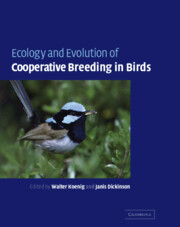Book contents
- Frontmatter
- Contents
- List of contributors
- Introduction
- 1 Evolutionary origins
- 2 Delayed dispersal
- 3 Fitness consequences of helping
- 4 Parental care, load-lightening, and costs
- 5 Mating systems and sexual conflict
- 6 Sex-ratio manipulation
- 7 Physiological ecology
- 8 Endocrinology
- 9 Incest and incest avoidance
- 10 Reproductive skew
- 11 Joint laying systems
- 12 Conservation biology
- 13 Mammals: comparisons and contrasts
- 14 Summary
- Names of bird and mammal species mentioned in the text
- References
- Taxonomic index
- Subject index
5 - Mating systems and sexual conflict
Published online by Cambridge University Press: 02 December 2009
- Frontmatter
- Contents
- List of contributors
- Introduction
- 1 Evolutionary origins
- 2 Delayed dispersal
- 3 Fitness consequences of helping
- 4 Parental care, load-lightening, and costs
- 5 Mating systems and sexual conflict
- 6 Sex-ratio manipulation
- 7 Physiological ecology
- 8 Endocrinology
- 9 Incest and incest avoidance
- 10 Reproductive skew
- 11 Joint laying systems
- 12 Conservation biology
- 13 Mammals: comparisons and contrasts
- 14 Summary
- Names of bird and mammal species mentioned in the text
- References
- Taxonomic index
- Subject index
Summary
Cooperative breeding occurs where more than two individuals contribute to a single brood of young, so it is certain that some individuals cannot be parents of some of the young they are rearing. By universal acclaim, studies of this phenomenon represent some of the most heroic field studies ever initiated, with several researchers following the fate of individuals within groups for decades (Stacey and Koenig 1990a).
Despite the admirable and detailed data achieved in these studies, there has been remarkably little crossing over from the study of avian cooperation into the burgeoning literature concerned with sexual selection. Indeed, a lot of research on cooperative breeding birds totally ignores the sex of the “helpers” that have prompted so much interest (Wright et al. 1999). No doubt part of the reason for ignoring gender arises because some cooperatively breeding birds are sexually monomorphic even as adults. Until recently, such monomorphism precluded identification of the sex of helpers without difficult and intrusive surgery. In addition, lack of obvious dimorphism or dichromatism might have been taken to indicate that sexual selection was of restricted importance in these species. However, as pointed out by Burley (1981), sexual conflict can lead to selection for concealing sexual identity. Such selection for indistinguishability may be particularly important in group-living species.
This chapter looks anew at the role of sex differences in the evolution of cooperative breeding, prompted by several considerations.
- Type
- Chapter
- Information
- Ecology and Evolution of Cooperative Breeding in Birds , pp. 81 - 101Publisher: Cambridge University PressPrint publication year: 2004
- 60
- Cited by



